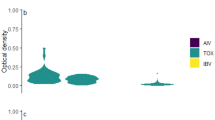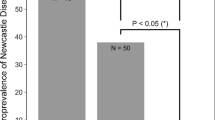Abstract
Long-term persistence of West Nile virus (WNV) infection within vertebrate reservoir hosts is a potential mechanism for overwintering of this (and other) arbovirus(es) at temperate latitudes. The house sparrow (Passer domesticus), an established amplifying host for WNV and other arboviruses, was used as a model to confirm chronicity of WNV infection in passerine birds and to evaluate the feasibility of two overwintering mechanisms: blood-borne infection of arthropod vectors (recrudescence) and oral infection of vertebrate reservoir hosts (ingestion of infected tissues through predation). WNV-inoculated sparrows were monitored for persistent infection for up to 2 years. Infectious virus persisted in tissues through 43 days, but not in sera beyond 6 days. Viral RNA persisted in tissues through 65 days. Chronicity of WNV infection in some tissues, but not blood, supports the predation mechanism of WNV overwintering, but not recrudescence. RNA persistence impacts interpretation and etiologic determination of avian mortality.
Similar content being viewed by others
References
Anderson JF, Main AJ (2006) Importance of vertical and horizontal transmission of West Nile virus by Culex pipiens in the Northeastern United States. J Infect Dis 194:1577–1579
Austgen LE, Bowen R, Bunning ML, Davis BS, Mitchell CJ, Chang G-JJ (2004) Experimental infection of cats and dogs with West Nile virus. Emerg Infect Dis 10:82–86
Beaty BJ, Calisher CH, Shope RE (1995) Arboviruses. In: Lennette EH, Lennette DA, Lennette ET (eds) Diagnostic procedures for viral, rickettsial, and chlamydial infections, 7th edn. American Public Health Association, Washington, pp 189–212
Bolling BG, Moore CG, Anderson SL, Blair CD, Beaty BJ (2007) Entomological studies along the Colorado front range during a period of intense West Nile virus activity. J Am Mosq Control Assoc 23:37–46
Bunning ML, Bowen RA, Cropp CB, Sullivan KG, Davis BS, Komar N, Godsey MS, Baker D, Hettler DL, Holmes DA, Biggerstaff BJ, Mitchell CJ (2002) Experimental infection of horses with West Nile virus. Emerg Infect Dis 8:380–386
Dawson JR, Stone WB, Ebel GD, Young DS, Galinski DS, Pensabene JP, Franke MA, Eidson M, Kramer LD (2007) Crow deaths caused by West Nile virus during winter. Emerg Infect Dis 13:1912–1914
Diamond MS, Shrestha B, Mehlhop E, Sitati E, Engle M (2003) Innate and adaptive immune responses determine protection against disseminated infection by West Nile encephalitis virus. Viral Immunol 16:259–278
Farajollahi A, Crans WJ, Bryant P, Wolf B, Burkhalter KL, Godsey MS, Aspen SE, Nasci RS (2005) Detection of West Nile viral RNA from an overwintering pool of Culex pipiens pipiens (Diptera: Culicidae) in New Jersey, 2003. J Med Entomol 42:490–494
Fedorova TN, Stavskiy AV (1972) Latent infection of wild ducks with Omsk hemorrhagic fever and West Nile viruses. In: Chumakov MP (ed) Aktualnye problemy virusologii i profilaktiki virusnykh zabolevaniy. Institute of Poliomyelitis Virus and Encephalitis AMN SSSR, Moscow, p 226 (in Russian)
Garmendia AE, Van Kruiningen HJ, French RA, Anderson JF, Andreadis TG, Kumar A, West B (2000) Recovery and identification of West Nile virus from a hawk in winter. J Clin Microbiol 38:3110–3111
Gerhold RW, Tate CM, Gibbs SE, Mead DG, Allison AB, Fischer JR (2007) Necropsy findings and arbovirus surveillance in mourning doves from the southeastern United States. J Wildl Dis 43:129–135
Godsey MS, Blackmore MS, Panella NA, Burkhalter K, Gottfried K, Halsey LA, Rutledge R, Langevin SA, Gates R, Lamonte KM, Lambert A, Lanciotti RS, Blackmore CGM, Loyless T, Stark L, Oliveri R, Conti L, Komar N (2005) West Nile virus epizootiology in the southeastern United States, 2001. Vector Borne Zoonotic Dis 5:82–89
Klenk K, Snow J, Morgan K, Bowen R, Stephens M, Foster F, Gordy P, Beckett S, Komar N, Gubler D, Bunning M (2004) Alligators as West Nile virus amplifiers. Emerg Infect Dis 10:2150–2155
Komar N, Langevin S, Hinten S, Nemeth N, Edwards E, Hettler D, Davis B, Bowen R, Bunning M (2003) Experimental infection of North American birds with the New York 1999 strain of West Nile virus. Emerg Infect Dis 9:311–322
Komar N, Panella NA, Burns JE, Dusza SW, Mascarenhas TM, Talbot TO (2001) Serologic evidence for West Nile virus infection in birds in the New York City vicinity during an outbreak in 1999. Emerg Infect Dis 7:621–625
Komar N, Panella NA, Langevin SA, Brault AC, Amador M, Edwards E, Owen JC (2005) Avian hosts for West Nile virus in St. Tammany Parish, Louisiana, 2002. Am J Trop Med Hyg 73:1031–1037
Kruszewicz AG (1995) The epizootic role of the house sparrow (Passer domesticus) and the tree sparrow (Passer montanus). Literature Review. In: Pinowski J, Kavanagh BP, Pinowska B (eds) Nestling mortality of granivorous birds due to microorganisms and toxic substances: Synthesis. Polish Scientific Publishers, Warsaw, pp 339–351
Kuno G (2001) Persistence of arboviruses and antiviral antibodies in vertebrate hosts: its occurrence and impacts. Rev Med Virol 11:165–190
Lanciotti RS, Kerst AJ, Nasci RS, Godsey MS, Mitchell CJ, Savage HM, Komar N, Panella NA, Allen BC, Volpe KE, Davis BS, Roehrig JT (2000) Rapid detection of West Nile virus from human clinical specimens, field-collected mosquitoes, and avian samples by a TaqMan reverse transcriptase-PCR assay. J Clin Microbiol 38:4066–4071
Lopes H, Redig P, Glaser A, Armien A, Wünschmann A (2007) Clinical findings, lesions, and viral antigen distribution in great gray owls (Strix nebulosa) and barred owls (Strix varia) with spontaneous West Nile virus infection. Avian Dis 51:140–145
Miura TA, Travanty EA, Oko L, Bielefeldt-Ohmann H, Weiss S, Beauchemin N, Holmes KV (2008) The spike glycoprotein of murine coronavirus MHV-JHM mediates receptor-independent infection and spread in the central nervous system of Ceacam1a −/− mice. J Virol 82:755–763
Nasci RS, Savage HM, White DJ, Miller JR, Cropp BC, Godsey MS, Kerst AJ, Bennett P, Gottfried K, Lanciotti RS (2001) West Nile virus in overwintering Culex mosquitoes, New York City, 2000. Emerg Infect Dis 7:1–3
Nemeth NM, Beckett S, Edwards E, Klenk K, Komar N (2007) Avian mortality surveillance for West Nile virus in Colorado. Am J Trop Med Hyg 76:431–437
Nemeth N, Gould D, Bowen R, Komar N (2006) Natural and experimental West Nile virus infection in five raptor species. J Wildl Dis 42:1–13
Nemeth NM, Kratz GE, Bates R, Scherpelz JA, Bowen RA, Komar N (2008) Naturally induced humoral immunity to West Nile virus infection in raptors. Ecohealth 5:298–304
Peiris JSM, Amerasinghe FP (1994) West Nile fever. In: Beran GW, Steele JH (eds) Handbook of zoonoses, section B. viral, 2nd edn. CRC Press, Boca Raton, pp 139–148
Phillips RA, Christensen K (2006) Field-caught Culex erythrothorax larvae found naturally infected with West Nile virus in Grand County, Utah. J Mosq Control Assoc 22:561–562
Pogodina VV, Frolova MP, Malenko GV, Fokina GI, Koreshkova GV, Kiseleva LL, Bochkova NG, Ralph NM (1983) Study on West Nile virus persistence in monkeys. Arch Virol 75:71–86
Reeves WC (1990) Overwintering of arboviruses. In: Reeves WC (ed) Epidemiology and control of mosquito-borne arboviruses in California, 1943–1987. California Mosquito and Vector Control Association, Sacramento, pp 357–382
Reisen WK, Chiles RE, Green EN, Fang Y, Mahmood F (2003) Previous infection protects house finches from re-infection with St. Louis encephalitis virus. J Med Entomol 40:300–305
Reisen WK, Chiles RE, Martinez V, Fang Y, Green E, Clark S (2004) Effect of dose on house finch infection with Western equine encephalomyelitis and St. Louis encephalitis viruses. J Med Entomol 41:978–981
Reisen WK, Fang Y, Lothrop HD, Martinez VM, Wilson J, O’Connor P, Carney R, Cahoon-Young B, Shafii M, Brault A (2006) Overwintering of West Nile virus in southern California. J Med Entomol 43:344–355
Reisen WK, Kramer LD, Chiles RE, Green E-GN, Martinez VM (2001) Encephalitis virus persistence in California birds: preliminary studies with house finches. J Med Entomol 38:393–399
Semenov BF, Chunikhin SP, Karmysheva VI, Iakovleva NI (1973) Study of chronic forms of arbovirus infections in birds. 1. Experiments with West Nile, Sindbis, Bhandja and Sicilian mosquito fever viruses. Vestn Akad Med Nauk SSSR 28:79–83 (in Russian)
Shrestha B, Diamond MS (2004) Role of CD8+ T cells in control of West Nile virus infection. J Virol 78:8312–8321
Taylor FM, Work TH, Hurlbut HS, Rizk F (1956) A study of the ecology of West Nile virus in Egypt. Am J Trop Med Hyg 5:579–620
Tesh RB, Parsons R, Siirin M, Randle Y, Sargent C, Guzman H, Wuithiranyagool T, Higgs S, Vanlandingham DL, Bala AA, Haas K, Zerinque B (2004) Year-round West Nile virus activity, Gulf Coast region, Texas and Louisiana. Emerg Infect Dis 10:1649–1652
Tesh RB, Siirin M, Guzman H, Travassos da Rosa APA, Wu X, Duan T, Lei H, Nunes MR, Xiao S-Y (2005) Persistent West Nile virus infection in the golden hamster: studies on its mechanism and possible implications for other flavivirus infections. J Infect Dis 192:287–295
Yaremych SA, Warner RE, Mankin PC, Brawn JD, Raim A, Novak R (2004) West Nile virus and high death rate in American crows. Emerg Infect Dis 10:709–711
Acknowledgments
We are grateful to P. Gordy, A. Bosco-Lauth, K. Jones, P. Oesterle, N. Roberts and others for logistical support. K. Burkhalter provided advice on RT-PCR and R. McLean provided editorial comments. This research was funded by National Institutes of Health contract N01-AI25489, Emerging Infectious Viral Disease Unit.
Author information
Authors and Affiliations
Corresponding author
Rights and permissions
About this article
Cite this article
Nemeth, N., Young, G., Ndaluka, C. et al. Persistent West Nile virus infection in the house sparrow (Passer domesticus). Arch Virol 154, 783–789 (2009). https://doi.org/10.1007/s00705-009-0369-x
Received:
Accepted:
Published:
Issue Date:
DOI: https://doi.org/10.1007/s00705-009-0369-x




